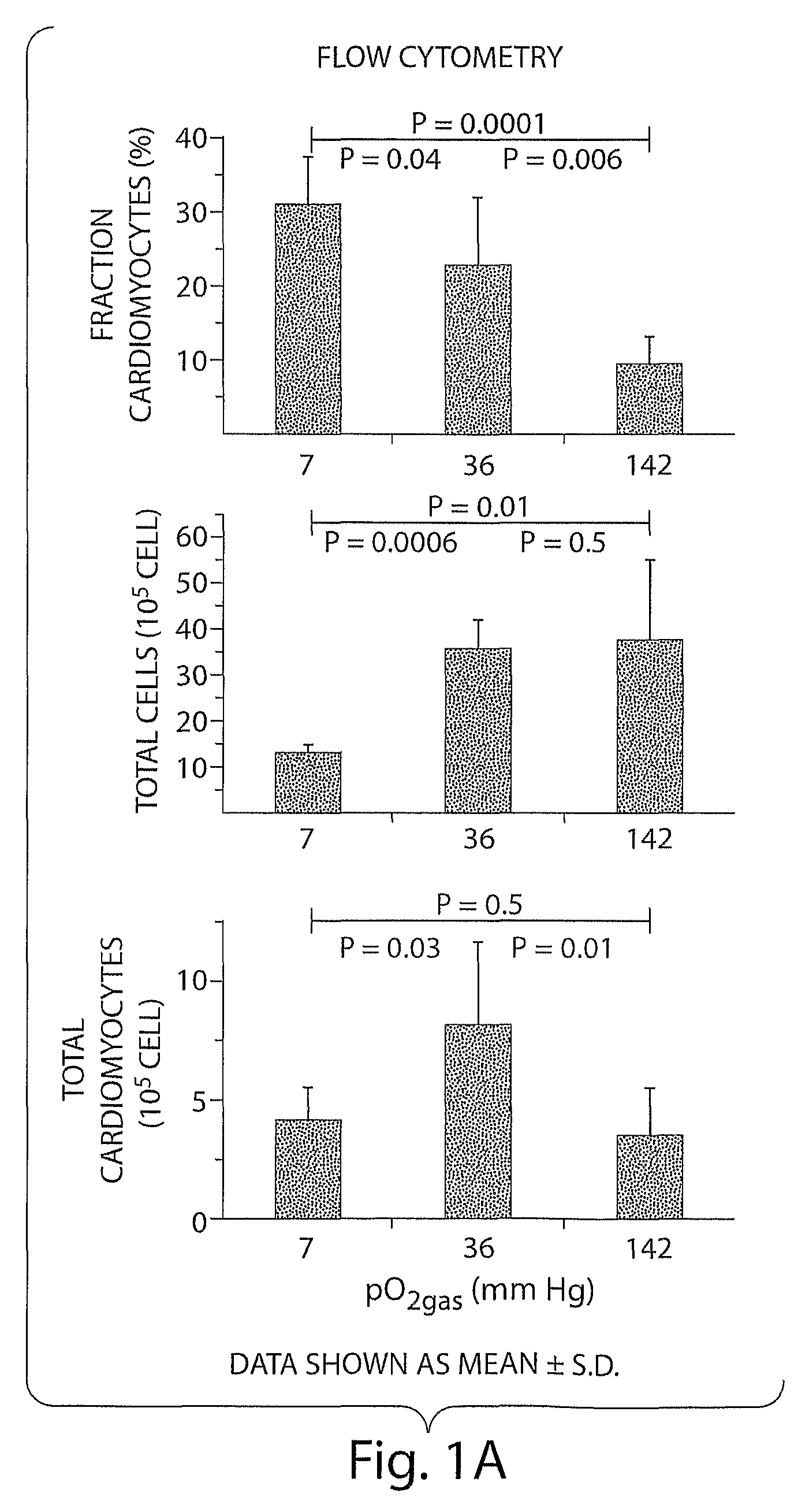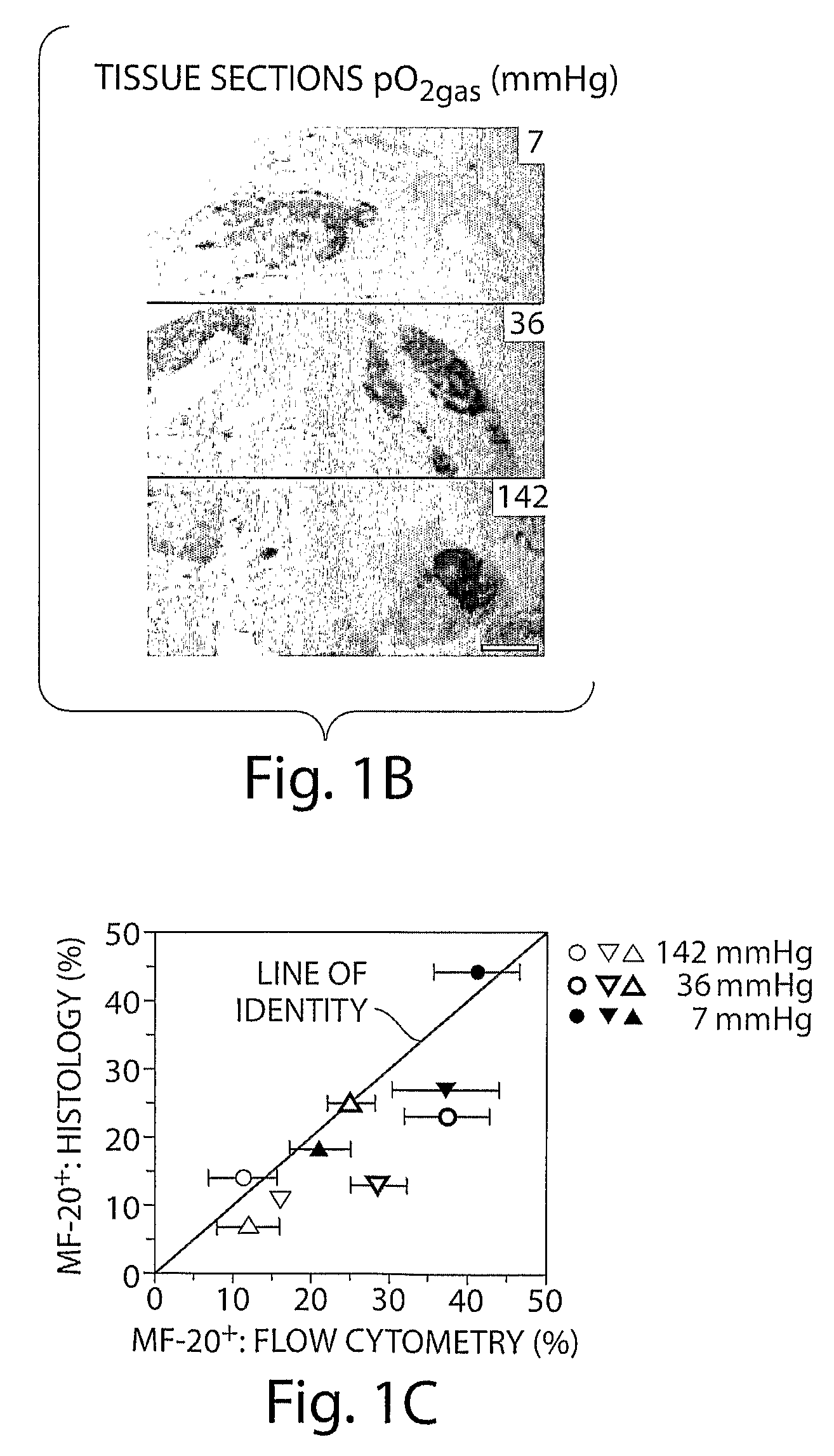Methods and compositions for enhanced differentiation from embryonic stem cells
a technology of embryonic stem cells and compositions, applied in the field of methods and compositions for enhanced differentiation from embryonic stem cells, can solve problems such as synergistic effects
- Summary
- Abstract
- Description
- Claims
- Application Information
AI Technical Summary
Benefits of technology
Problems solved by technology
Method used
Image
Examples
example 1
Introduction
[0128]Most ES cell research is performed in incubators with a humidified 95% air / 5% CO2 gas mixture, resulting in a gas-phase oxygen partial pressure (pO2gas) of 142 mmHg. Embryonic cells in early development are exposed to pO2cell values of about 0-30 mmHg, and the effects of such conditions on differentiating ES cells are poorly understood. It is now shown that control of the pO2cell to levels experienced by developing embryos enhances differentiation of ES cells into cardiomyocytes. The fraction of cells that are cardiomyocytes is maximized by initial culture at pO2cell values less than 7 mmHg, whereas cardiomyocyte number is maximized by subsequent culture at high pO2cell. Under the best conditions examined, the fraction and number of cardiomyocytes increases 3-fold compared to culture at high pO2cell throughout differentiation. These results demonstrate that pO2cell is an important factor for enhancing directed differentiation of ES cells into cardiomyocytes for the...
example 2
[0171]ES cells were differentiated on silicone rubber-bottom dishes, which are highly permeable to oxygen and allow for better control of pO2 to the cells. When results were repeated on polystyrene dishes, no spontaneously beating cells were observed. Below are a list and explanation of relevant methods used in cell culture.
Materials and Methods:
[0172]Undifferentiated ES cell culture. J1 and R1ES cells were obtained from ATCC(SCRC 1010, SCRC 1036, Manassaas, Va.), expanded on Mitomycin-C treated MEF cells, and frozen into vials following ATCC protocols. Vials were thawed into undifferentiated ES cell maintenance medium (described in Table 1) containing supplemental leukaemia inhibitory factor (LIF) and plated at a density of about 5×104 cell / cm2 on 25 cm2 cell culture flasks (353109, Becton Dickinson, Franklin Lakes, N.J.) that were treated for 30 min. with a sterile 0.1% (w / v) solution of gelatine (G-2500, Sigma-Aldrich, St. Louis, Mo.) in tissue culture water (WFI, 25-055-CM, Medi...
example 3
[0178]Low Oxygen and Ascorbic Acid Act Synergistically to Promote Cardiomyocyte Generation. mES cells were differentiated for 10 days at 142, 36, and 7 mmHg pO2 and with either 0 or 0.2 mM ascorbic acid. Cardiomyocyte generation was measured by counting fixed cells immunostained for sacromeric myosin heavy chain using the MF-20 with a flow cytometer. At all ascorbic acid conditions, low pO2 increased cardiomyocyte generation. At all pO2, ascorbic acid increased cardiomyocyte generation. However, when 0.2 mM ascorbic acid was combined with 36 mmHg pO2, a larger increase in cardiomyocytes than with either method alone was observed. (FIGS. 10 and 11.). The presence of ascorbic acid and pO2gas together and separately also had a large effect on morphology (FIG. 12).
PUM
| Property | Measurement | Unit |
|---|---|---|
| partial pressure | aaaaa | aaaaa |
| oxygen partial pressure | aaaaa | aaaaa |
| oxygen partial pressure | aaaaa | aaaaa |
Abstract
Description
Claims
Application Information
 Login to View More
Login to View More - R&D
- Intellectual Property
- Life Sciences
- Materials
- Tech Scout
- Unparalleled Data Quality
- Higher Quality Content
- 60% Fewer Hallucinations
Browse by: Latest US Patents, China's latest patents, Technical Efficacy Thesaurus, Application Domain, Technology Topic, Popular Technical Reports.
© 2025 PatSnap. All rights reserved.Legal|Privacy policy|Modern Slavery Act Transparency Statement|Sitemap|About US| Contact US: help@patsnap.com



